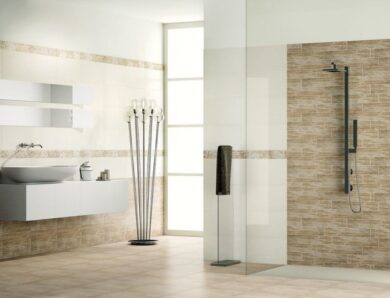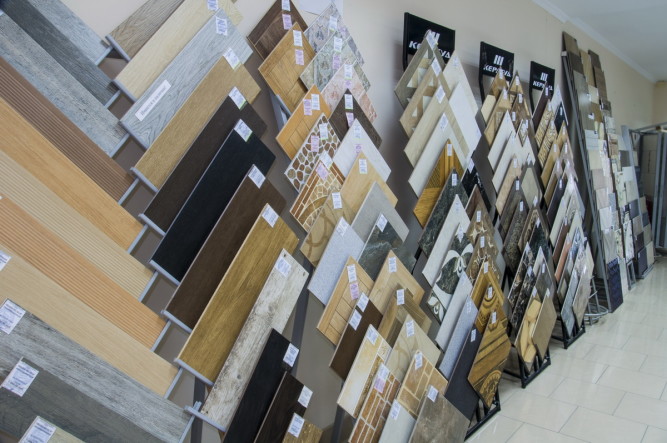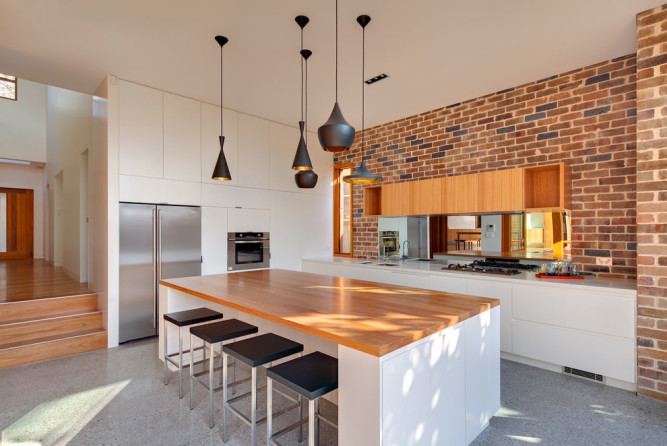
Laying decorative tiles under the brick with your own hands
To create an aesthetic surface both externally, and inside the building is widely used method of laying decorative tiles under the brick. This type of cladding can be made of different materials. The simplest and most affordable is gypsum. Let's take a closer look, how to lay such a coating with your own hands.

Gypsum brick tiles are often used for interior decoration
Types of materials
In the modern construction market you can find a variety of decorative finishing materials. Elements are in great demand, imitating brick or stone. They can be made of different materials, the most popular products are:
- Clinker. Very durable and wear-resistant material, can be completely different colors, used for any type of surface as outside, and inside buildings.
- Gypsum. Quite fragile, but light material, which is used mainly for interior work. Initially white, can be painted in liquid form, and after the manufacture or installation of the element.
- Polyurethane. Very light and widely used material in interior work, mostly white, but may contain pigments.
- Polyfoam. Lightweight and fragile material, used for interior decoration. White color.
For works on a decor of premises the optimum variant will be laying of a tile under a brick, made of gypsum. It is cheaper than clinker, it is much stronger than polymer analogues and looks more natural.

Varieties of finishing materials for interior and exterior works
Decorative plaster tiles can be made with your own hands. To do this, mix water, gypsum powder and plasticizer in the form of PVA glue. Pour the mixture into the prepared form and wait for it to dry. You can add pigment to paint the mass or apply paint to the bottom of the form before pouring.
Used glue
To lay gypsum tiles with your own hands, you need to choose the right glue. so, consider, on what it is possible to glue a plaster tile. There are several options:
- Ordinary cement tile adhesive. It is used for laying tiles. This is a standard option for laying almost any cladding.
- Gypsum plaster. The best option for finishing the premises. The mixture has a white tint, therefore it is practically invisible under a tile.
- Silicone sealant. Quite unusual, but a very effective solution. Provides strong adhesion to the surface.
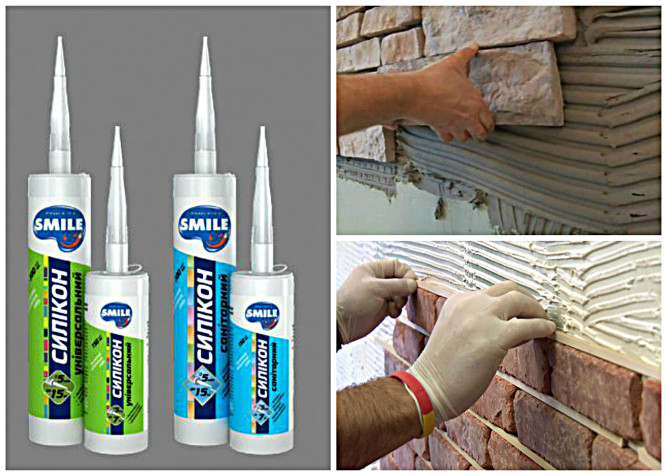
Options of glue for laying gypsum tiles
When using cladding outside the building, it is important to choose a frost-resistant adhesive mixture, otherwise, after a few cycles, the solution will begin to crumble and crumble along with the tile.
Adhesive for decorative gypsum tiles must be fresh. If the bag with the mixture has stood open for several months, probably, it will quickly harden or get lumpy. This will greatly complicate the work with the mixture and also worsen the quality of adhesion of materials.
Surface preparation
Before you start laying decorative tiles with your own hands, regardless of its type, it is important to prepare the surface, intended for facing. Requirements for this stage of work are standard. First of all, it is important to remove the old coating, if any. Old glue and mortar must be washed off thoroughly.
After that, you need to plaster the walls, to get rid of all the bumps on the surface. It is important to remove all inflows and pits, as by means of glue it is hardly possible to block them. At considerable differences apply gypsum cardboard, it can be fixed on a metal frame or glued directly to the wall.

Before laying the tiles, it is recommended to level the surface with plaster
All dust and dirt must be removed. All dust and dirt must be removed, All dust and dirt must be removed. All dust and dirt must be removed.
All dust and dirt must be removed
All dust and dirt must be removed, All dust and dirt must be removed, All dust and dirt must be removed. All dust and dirt must be removed. All dust and dirt must be removed, All dust and dirt must be removed, All dust and dirt must be removed, and if equal - only toothed.
How to glue decorative tiles with your own hands:
- Apply a little glue to the wall in a thin layer. It should be enough for stacking 4-5 elements.
- Also apply a little mortar on the back of the tile.
- Press the plaster against the wall and adjust its position. Use plastic spacers to align the seams.
- Each row should be placed with an offset in the floor-element.
- The solution appearing in seams needs to be removed at once with a rubber spatula and to wash away the rests with a brush, soaked in clean water.
You do not need to dilute a lot of solution, if you overdo it, he will start to seize and it will be impossible to work with him.
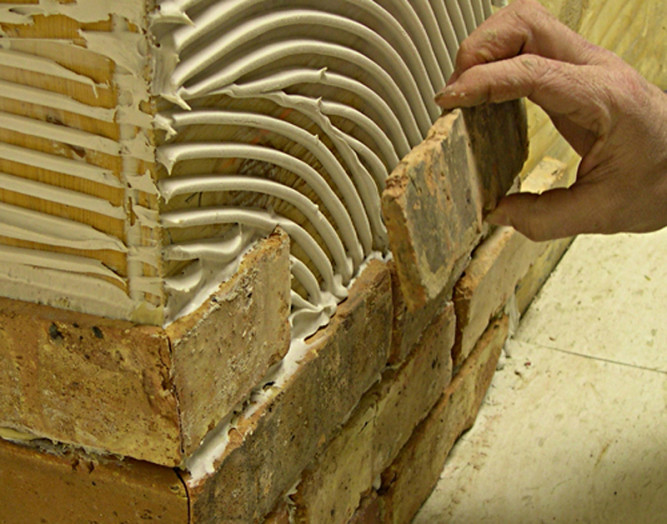
Properly covered, it will withstand a great deal of adverse conditions
Decorative finishing
The last stage is decorative finishing. First of all it is necessary to clear glue, if it protrudes above the tile. Be sure to seal the joints between the plaster elements. You can do this with your own hands in two ways:
- Adhesive solution. Allows you to create an imitation of real brickwork. For this purpose it is necessary to seal plaster with a painting tape along joints and by means of a spatula to fill seams with a solution.. After it dries, you can remove the protective strips.
- Grout. This is the best option. To work with gypsum, you will need a pastry bag or construction syringe. Fill it with diluted mastic and carefully walk all the seams. They need to be filled to about half full.
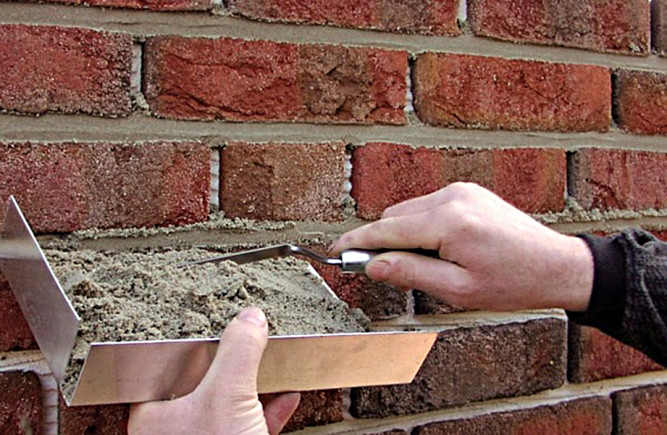
Grouting the joints after laying the tiles is the final stage of work
Additionally, you can cover the gypsum tile with paint. This is done in that case, if white elements were used, and you want to increase their resemblance to brick or stone. It is best to use an airbrush for this purpose.
To protect the tile from moisture and dirt, it must be treated with a special solution. It will create a water-repellent film and increase the color intensity of the coating. It should be evenly sprayed on the veneered surface after complete drying of the grout and paint. After that, you can safely wipe the plaster with a damp cloth and wash it in case of heavy soiling. This treatment is easy to do with your own hands and is a must when using drywall on the street, example, to decorate the veranda or balcony.
Now you know how to line the walls with decorative tiles. In addition to gypsum, other materials can be used, the technology of working with them is little different from that presented.

